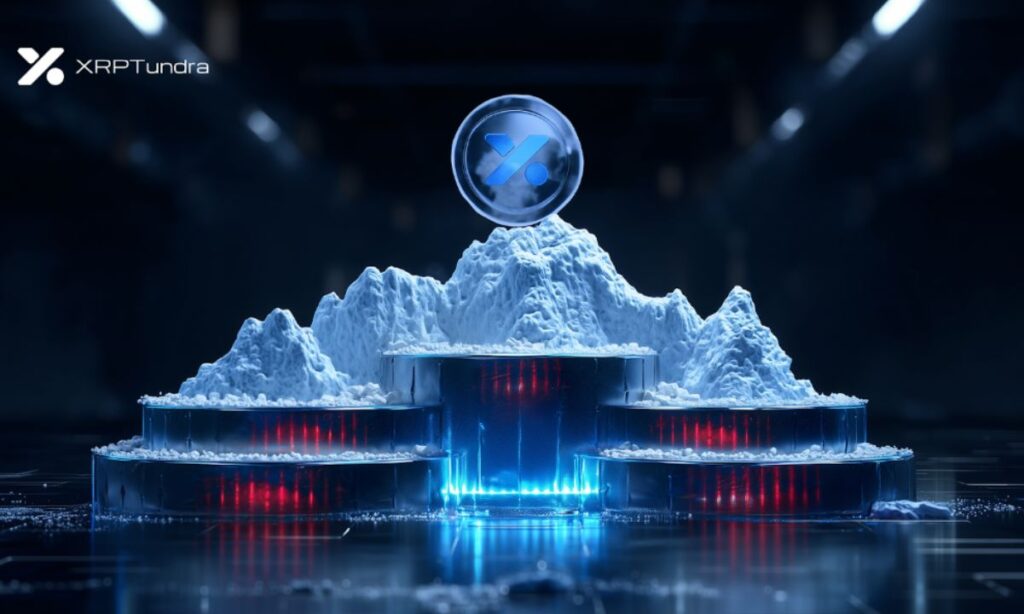XRP Tundra operates on two ledgers: the XRP Ledger (XRPL) for governance and reserves, and Solana for high-throughput execution. To keep both environments in sync, the project integrates Chainlink oracles as a database for price inputs, emission records, and validator measurements. Delivering Oracle to both chains removes manual coordination and keeps staking and governance logic aligned in real time.
The new Oracle layer defines how information flows through Tundra’s dual-token architecture, ensuring that every update, calculation, and reward event references identical verified data on every ledger. It also prepares the infrastructure for Cryo Vault staking and GlacierChain Layer-2 expansion, where the same power system will extend to automated reporting and compliance validation in Ripple’s growing DeFi ecosystem.
Chainlink on two ledgers: single source, double delivery
Tundra routes identical Oracle updates to Solana programs and XRPL smart contracts. Chainlink nodes sign and broadcast data packets that include a timestamp, source set, and aggregation result. On Solana, Cryo Vault and liquidity programs consume the feed for the reward calculation and issuance programs. On XRPL, TUNDRA-X governance contracts store the same packet hash to create a mirrored record.
When a new data point arrives – like a time-weighted reference price – the Solana side applies it to staking accumulations while XRPL records the hash and block height. If either side detects an incompatibility (hash or sequence), updates stop until the next consistent packet arrives. This symmetry ensures that both registers contain the same facts before any state change.
Data flow for price, emissions and validator measurements
Three categories of input pass through Chainlink:
Price references. Reward calculations and threshold controls use Oracle-based reference prices to avoid stale or manipulatable inputs. The system uses rolling window aggregation to mitigate short-term volatility.
Emission control points. Each distribution window refers to a Chainlink signed packet that includes the period ID and a summary of accumulated rewards. XRPL keeps the summary; Solana executes the distribution. Either ledger can prove that the distribution matches the signed parameters by verifying the same hash.
Validator and availability measurements. Governance on XRPL receives periodic summaries of validator performance and transmits heartbeat data. These measures do not grant operational control; they provide a signed, reproducible file that proposals and rotations can reference.
In practice: Solana calculates, XRPL attests and Chainlink guarantees that both parties have seen the same data.
Oracle Security Controls and Audits Published
Controls follow a “check then act” model. Contracts only accept updates from authorized Chainlink node addresses; packets must pass signature, timestamp, and sequence checks. Old or out-of-order packets are discarded. Distribution contracts fail if an on-chain check does not match the last stored summary.
Independent audits confirm plumbing:
- Cyberscope reviewed calls on the Solana side and verified that Oracle consumers enforce signature allowlists and sequence monotony.
- Solidproof reviewed the XRPL storage and confirmed the packet hashes, timestamp windows, and shutdown conditions in case of inconsistency.
- FreshCoins simulated update runs and verified that failed reconciliations do not release emissions.
These results show that the Oracle layer is non-custodial and deterministic: Chainlink provides data; validation of ledgers; state changes only occur after both confirmations exist on the chain.
For an accessible overview of Oracle-based DeFi design, HotCuppaCrypto explains how signed data governs rewards and risk controls in modern protocols.
Effects on Cryo Vault staking and rewards
Cryo Vaults – Tundra’s XRP staking mechanism – uses Chainlink entries to anchor reward calculations. Target returns (up to 20% APY at launch) rely on Oracle-verified time frames and benchmark prices to prevent gaming. At the end of a period, Solana calculates distributions; XRPL stores the corresponding summary; funds are only moved when the summary of the two ledgers matches the signed package.
This structure supports predictable accruals and verifiable payments:
- Predictable schedule: distribution windows are defined as a string and linked to Oracle sequence numbers.
- Verifiable mathematics: anyone can recalculate the totals using the same packet values and compare with Solana’s ledger.
- Safety stops: If a package is missing or outdated, rewards do not advance until a valid update arrives.
The result is a staking system that treats data as a shared source of truth rather than a local estimate.
Pre-sale progress and the road ahead
The Phase 9 presale sets TUNDRA-S at $0.147 with an 11% bonus and uses a $0.0735 benchmark for TUNDRA-X. The Oracle layer underpins both emissions and governance from launch.
Next, GlacierChain – an XRPL Layer-2 coordination module – will consume the same Chainlink packets for automated reporting and proposal checks. With identical data feeding the base layers and layer 2, proposals can include deterministic assertions (“this broadcast equals packet n”) and produce audit-ready logs without manual reconciliation.
Completion of Phase 9 will finalize the infrastructure funding required for Cryo Vault enablement, ensuring that Layer 2 staking, governance, and automation will all be initiated on a fully synchronized and Oracle-verified basis.
Learn how Chainlink signed data powers Tundra staking and governance:
Check Tundra Now: XRP Tundra official website
How to catch the tundra: step by step guide
Security and trust: audits — Foolproof audit
Join the community: Telegram
Disclaimer: The article above is sponsored content; it’s written by a third party. CryptoPotato does not endorse or assume any responsibility for the content, advertising, products, quality, accuracy or other material on this page. Nothing in this material should be construed as financial advice. Readers are strongly advised to verify the information independently and carefully before committing to any business or project mentioned and to do their own research. Investing in cryptocurrencies carries a risk of capital loss, and readers are also advised to seek professional advice before making any decisions based or not on the sponsored content above.
Readers are also advised to read the full CryptoPotato disclaimer.
SECRET PARTNERSHIP BONUS for CryptoPotato readers: Use this link to sign up and unlock $1,500 in exclusive BingX Exchange rewards (limited time offer).




